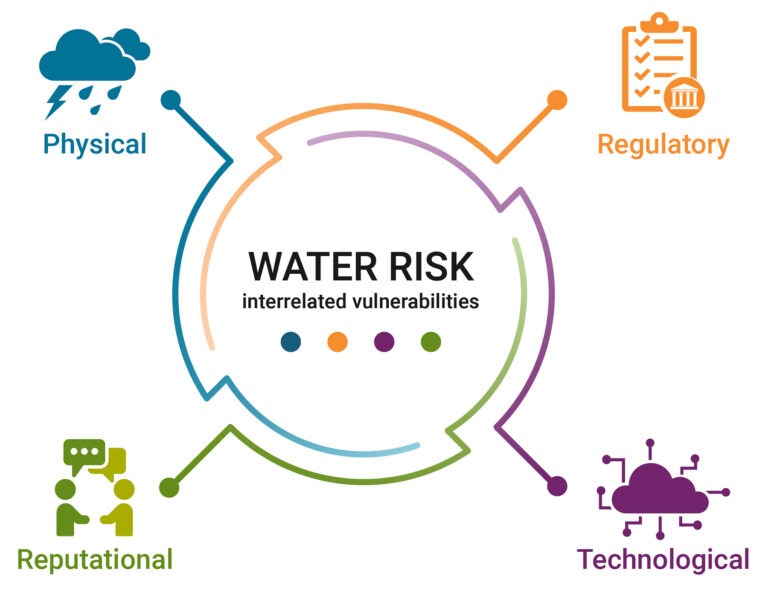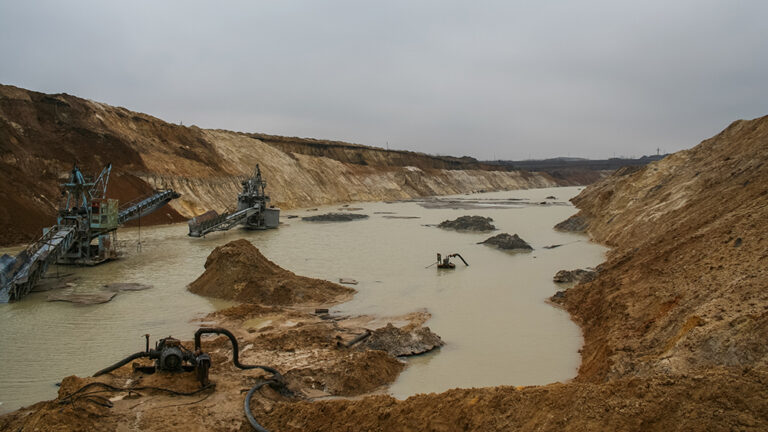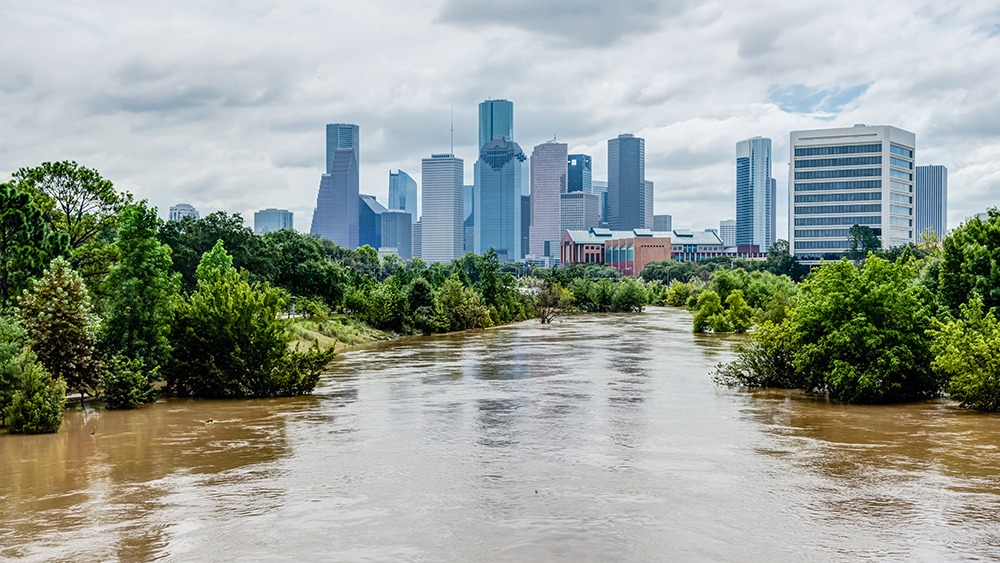Our communities, businesses, economies, and natural environment face growing water-related challenges and impacts.
These challenges are diverse and often disruptive, and they sometimes have devastating consequences for lives, livelihoods, and economies. Worldwide, over 90 percent of natural disasters are water- and weather-related, including drought, wildfires, pollution, and floods. In 2023, the National Oceanic and Atmospheric Administration confirmed 28 weather and climate disaster events that affected the United States, with losses exceeding $1 billion each. Since 1980, losses related to such events have exceeded $2.6 trillion.
As demand for water grows, infrastructure ages, and climate change makes water-related challenges more frequent and dynamic, such costs are likely to increase.
Also, there are many water challenges outside of natural disasters that can be disruptive and costly, such as contaminated water supplies, operational inefficiencies and upsets, evolving regulations and costs, environmental liabilities, and water security, that businesses must contend with regularly.
No aspect of our communities, economies, or environment is immune to both the need for water and its inherent challenges. This duality often confounds decision making due to conflicting stakeholder objectives and shifting priorities. From industrial, mining, and agriculture operations to technology, utilities, and energy producers, water security and stewardship are critical and growing concerns. The need for sustainable water management and resource protection is further amplified as water resources become stressed under increasing demands.
What is water risk?
The UN Global Compact’s CEO Water Mandate defines water risk as the possibility of an entity or asset experiencing a water-related challenge. These challenges take many forms:
- Water supply accessibility and reliability, driven, for example, by inadequate water storage or treatment systems, groundwater depletion, imperiled surface waters, and competing demands from agriculture, industry, urban areas, and environmental protection.
- Water supply quality, which can be degraded by salinity, pollutant discharges, aging infrastructure, and poor waste management.
- Flooding, a growing threat as sea levels rise, flood patterns change, and storms intensify with climate change. Flooding often disproportionately affects vulnerable populations.
- Infrastructure failure, a potential consequence of extreme weather events.
- Droughts, which, due to climate change, may become more intense and increasingly impact geographical areas unaccustomed to drought stress.
- Regulatory discharge limits, which may necessitate water treatment, regulatory tracking, and sampling programs for compliance.
- Supply chain disruption, which could follow floods or storms and impact transportation networks or vulnerable suppliers at any point in an operation’s supply chain. A common example is food supply disruption due to drought, freezes, and flooding.
- Energy-water nexus challenges, because energy is required to withdraw, treat, and distribute water to the point of use, and energy is also consumed as water is used in industrial, manufacturing, agricultural, and cooling processes. Likewise, water resources serve a critical role in the generation of electricity and the production of fuels and can significantly affect the reliability and resilience of energy systems.
- Regulatory uncertainty driven by changing administrations, policies, permitting requirements, regulations, legal challenges, and interpretations.
- Knowledge management due to, e.g., employee turnover, reorganization, poor data management, and technology transitions.
- Community opposition to infrastructure modernization or other development projects.

These challenges can evolve slowly — as in the case of a water supply dwindling over years of drought — or occur abruptly, as in the case of flooding caused by a storm. The extent of the risk involved is a function of the likelihood of a specific challenge occurring and the severity of the challenge’s impact, which, in turn, depends on the intensity of the challenge and the vulnerability of the stakeholder or asset. Simultaneous or frequent challenges — such as more frequent and intense storm events — can amplify impacts.
When it comes to water, standard risk management approaches — including avoidance, mitigation, transference, and acceptance — present unique challenges and opportunities. Past risk assumptions may not be appropriate for many locations and industries due to evolving uncertainties and knowledge.
For example, a mining client in Arizona came to us for guidance because its stormwater flow model did not accurately predict what happens during real-world storms at its facility, which created the risk that the company would have to adopt costly measures to meet regulatory requirements. Suspecting that the existing discharge estimates were predicated on overly conservative precipitation discharge models, we conducted testing and monitoring at the site to understand the real-world precipitation levels and stormwater flow and devise a solution that would protect the environment and meet regulations.
How can you manage water risk and make operations more resilient?
Given that water risk encompasses such a wide, sometimes competing range of challenges, operations need multidisciplinary expertise and a holistic approach to properly integrate best practices for resource and risk management. They also need to ensure that the risk management strategies they adopt today can adapt to the uncertainties of tomorrow.
The following steps can help manage water risk:
Understand your vulnerabilities. We can think about water risk in four major categories: physical, regulatory, reputational, and technological. All four elements are interrelated, but an understanding of each can guide priorities and create a big-picture view of your current risk profile.
- Physical risk. As the most visible aspect of water risk, physical risk often manifests as the effects of flooding, drought, landslides, inadequate infrastructure, erosion, water stress, ecosystem vulnerability, and water quality. Familiar examples of risk mitigation measures include engineering structures for flood protection or securing more reliable water supplies.
- Regulatory risk. This aspect encompasses concerns such as evolving regulations, rising water costs, regulatory permitting uncertainty, water laws, and water allocation limits. The administration of water rights, laws, and regulations can vary significantly across jurisdictional boundaries, which can contribute to compliance and operational challenges.
- Reputational risk. Given water’s centrality to healthy, prosperous communities and the increased public scrutiny of corporate environmental, social, and governance concerns, including environmental justice, projects that impact water supplies can draw intense scrutiny from local communities and other partners. Reputational risk factors include potential community opposition, shareholder concern and litigation, creditworthiness, insurability, and investment community expectations.
- Technological risk. This risk area encompasses data governance, decision barriers, knowledge gaps, data quality, technology debt, technology transition, and change management. In other words, does a company have the right technology and practices in place for informed operational, compliance, and safety-related decisions as water challenges arise? Effective decision support solutions require careful assessment and implementation to prove useful and provide value.

Assess your vulnerabilities to find your opportunities. A systematic look at each risk area mentioned above can help operations find where they are most vulnerable, which, in turn, can help prioritize mitigation efforts.
A risk assessment can also help you identify the vulnerability of assets to water stranding, that is, assets that have or could stop producing a return due to a water-related event, such as flooding, inadequate water supply, poor water quality, or regulatory noncompliance.Without proactive actions, stranded assets can evolve into long-term liabilities.
A thorough understanding of your risk can also reveal water-related opportunities: the possibility that you can drive value and positive outcomes through better water management.
What is a water opportunity?
With proper planning, tactics for managing risk can accomplish multiple goals — increasing the efficiency of your current water use, making progress toward internal sustainability commitments, and helping you better mitigate water risk. They can also accompany other risk management measures — for example, for a client in the Pacific Northwest that wanted to make its facilities more resilient to the impacts of the Cascadia Subduction Zone earthquake, we incorporated a greywater reuse system and on-site tanks for potable water into much broader site improvement plans.
Water opportunities can include:
- Efficiency gains. These gains include cutting water use by modernizing systems and practices to eliminate leaks and waste, performing regular water audits, and co-optimizing water and energy efficiency.
- Recycling, reclamation, and restoration. These opportunities also increase efficiency and can make your site more self-sufficient or protected in the event of a water-related emergency. For example, a restored coastal marsh can mitigate the impacts of storms and flooding.
- Opportunities to benefit your community. For example, that same restored coastal marsh could provide your community with recreation and wildlife habitat.
- Risk mitigation cost sharing. Federal and nonfederal funding programs, such as EPA brownfields, stormwater, and infrastructure grants, offer cost-sharing opportunities, some of which can pair risk mitigation with conservation efforts. Stakeholder collaboration can also achieve mutually beneficial outcomes.
- Nature-based solutions. Green roofs, permeable pavement, bioswales, and other green-design choices can protect water quality and offer side benefits, such as better air quality, wildlife habitat, and aesthetic appeal.
- Technology sharing and leveraging. Properly aligned technology can provide cost savings while mitigating water risk — such as a water monitoring program that informs compliance and operational decisions or sharing information with stakeholders for transparency or to inspire innovative solutions.
- A chance to employ the best available science and practices. A growing wealth of resources is available to guide risk mitigation and adaptation investment decisions.
- Lower insurance costs. Demonstrating proactive water risk reduction measures can lower insurance costs and validate insurability.
- Safer operations. Effective water risk mitigation protects people, assets, businesses, and the environment.
- Future cost avoidance. By planning today, you can incorporate water risk reductions and sustainability into ongoing improvement plans to reduce future costs or build a water-resilient supply chain to protect future revenues.
- Better monitoring of industry and international standards. The Alliance for Water Stewardship, the Global Reporting Initiative, the Sustainability Accounting Standards Board, CEO Water Mandate, and many other bodies offer regulatory and industry guidance related to water risk. Operations increasingly need to account for and disclose their sustainability, water stewardship, and water risk and opportunity initiatives. Tracking those standards and understanding your current state can build a more robust, accurate reporting structure.
As trusted advisors, Haley & Aldrich can help you navigate and thrive in this complex and evolving landscape. We tailor integrated solutions to your specific goals and vulnerabilities — giving you a strong foundation on which to build and sustain resilient, efficient, and adaptable operations. Contact the authors for more information.
Published: 4/25/2024
- Energy
- Government infrastructure
- Industrial and manufacturing
- Food and beverage
- Ports, harbors, and coastal Infrastructure
- Transportation
- Manufacturing
- Mining
- Real estate developers
- Construction
- Contaminated site management
- Environmental due diligence
- Environmental risk assessment
- EHS compliance
- Water quality
- Sustainability
- Disaster and climate resilience services
- Water resources
- Groundwater
- Stormwater
- Surface water
Author

Technical Expert, Senior Hydrogeologist




